11 Best Ghost Shrimp Tank Mates (With Pictures)
Fishkeepers love the Ghost Shrimp due to its appearance which is very unique from other shrimps.
The Ghost Shrimp has a translucent body, this makes Ghost Shrimps glasslike. This is why people also refer to the Ghost Shrimp as Glass Shrimp.
The Ghost Shrimp is a very endurant crustacean. It tolerates changing water conditions, isn’t prone to disease, and eats almost anything.
Adding the Ghost Shrimp in a community tank is a good idea. There’s no problem so long as it lives with very compatible tank mates.
So what aquatic animals does the Ghost Shrimp get along with?
Here are some of the best ghost shrimp tank mates that you shouldn’t hesitate to get.
Table of Contents
Cheery Barb
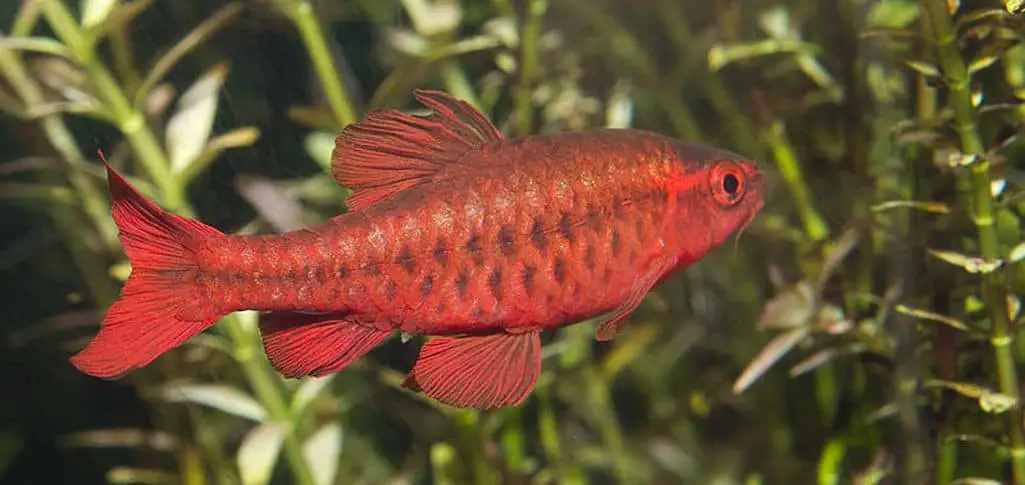
Paules Edward Peiris Deraniyagala named the Cherry Barb in 1929. This fish is native to Sri Lanka.
However, some populations are thriving in Mexico and Colombia due to breeding.
The Cherry barb has bright orange or pink coloration. It has large scales with a slightly brownish hue.
Cherry Barbs love to swim in schools consisting of 10 members. Usually, they swim near plants to look for food. When exploring, they’re usually found in the open areas of the water.
The Cherry Barb grows up to 5 cm. This fish is sold cheap. Fishkeepers sell the Cherry Barb for $2 or $3.
When raising this with your Ghost Shrimp, use a very spacious tank and provides lots of hiding places.
Cherry Barb Profile
• Other Names: None
• Life Span: 4 Years
• Diet: Fined-Sliced Veggies, Brine Shrimp, and Freeze-Dried Bloodworms
• Preferred Water Conditions: Freshwater, Slightly Acidic, Acidic, Cool (23 – 27 degrees Celsius)
• Minimum Tank Requirement: 30 Gallons (6 Cherry Barbs)
• Suitable Tank Mates: Ghost Shrimp, Tetras, Pearl Danios, and Glass Catfish
Neon Tetra

The first specimens of the Neon Tetra were collected by William Thornton Innes III. However, George S. Mayers was the person who gave the first scientific description of the Neon Tetra in 1936.
This fish is native to Colombia, Peru, and western Brazil. However, other populations might be in other parts of the western and northern Amazon Basin.
The coloration of the Neon Tetra is a combination of black, red, and neon blue. Black dominates the portion of its body near the dorsal fin.
A neon blue line is on the side of its body which spans from tail to head.
Lastly, there’s a red marking that spans from the belly up to the underside of the Neon Tetra’s tail.
The Neon Tetra may reach a maximum length of 1.4 inches. Right now, this fish is sold for $1 or $2.
Neon Tetra Profile
• Other Names: None
• Life Span: 8 – 10 Years
• Diet: Brine Shrimp, Fish Eggs, Bloodworms, Daphnia, and Zooplankton.
• Preferred Water Conditions: Freshwater, Neutral, Cool (22 – 25 degrees Celsius)
• Minimum Tank Requirement: 15 Gallons (15 Neon Tetras)
• Suitable Tank Mates: Ghost Shrimp, Rasboras, Cherry Barbs, Cory Fish, and Dwarf Gourami.
Hatchetfish
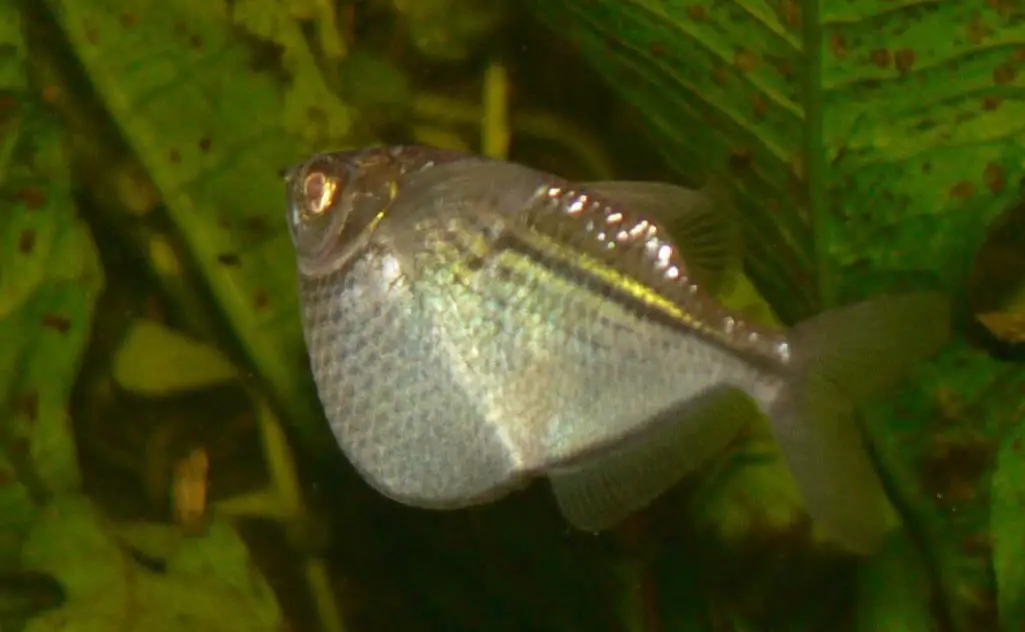
The Hatchetfish hails from the waters of South and Central America. There about 17 varieties of Hatchetfish at present.
These swim in various waters all over the world. Some dwell on freshwater, saltwater, and the deepest darkest part of the ocean.
All Hatchetfish have the signature bulging belly. They come in a silvery coloration. Furthermore, a green hue, yellowish hue, or spotted pattern my accompany this.
Depending on its variety, a Hatchetfish may reach a maximum size of 2.5 inches or 6 inches.
Common Hatchetish is the most popular kind of Hatchetfish for community tanks. Fishkeepers love it because it’s very docile.
It strives to hide instead of attacking other fish when provoked.
Hatchetfish Profile
• Other Names: None
• Life Span: 5 Years
• Diet: Brine Shrimp, Tubifex, Bloodworms, and Carnivore Pellets
• Preferred Water Conditions: Freshwater, Slightly Acidic, Acidic, Slightly Warm (22 – 27 degrees Celsius)
• Minimum Tank Requirement: 20 Gallons (6 Hatchetfish)
• Suitable Tank Mates: Ghost Shrimp, Tetras, Loricariids, Dwarf Cichlids, and Cory fish
Danios
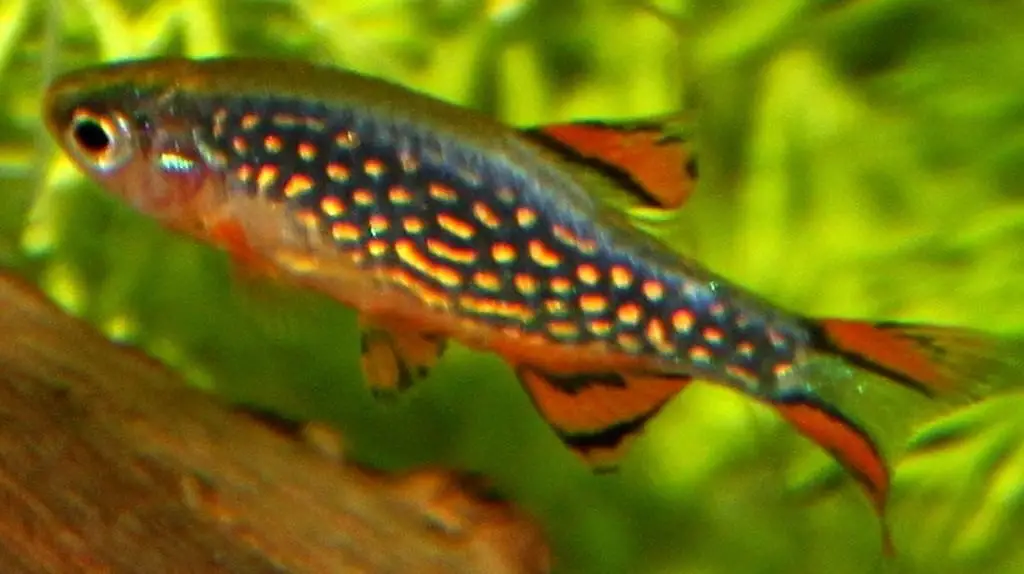
Danios are freshwater fishes that are native to countries in Southeast Asia. These fishes are surface dwellers. They’re very active and do well in large and small tanks.
Available colors for Danios are silver, yellow patterned, black patterned, reddish, yellowish, and brownish. There are 15 species of Danios at present.
However, the most beautiful ones are the Celestial Danio, Queen Danio, Spotted Danio, and Danio Tinwini.
Between these, I suggest that you pick the Celestial Danio because it’s one of the best ghost shrimp tank mates that’s not sensitive.
Regardless of specie, Danios usually grow up to 2 inches. Furthermore, pricing for a Danio varies depending on its color and behavior.
Danio Profile
• Other Names: None
• Life Span: 3 – 4 Years
• Diet: Flakes, Granules, and Shrimp Pellets
• Preferred Water Conditions: Freshwater, Neutral, Cool (21 – 25 degrees Celsius)
• Minimum Tank Requirement: 15 Gallons (5 Danios)
• Suitable Tank Mates: Ghost Shrimp, Serpae, Red Eye Tetras, Black Skirt Tetras, Swordtails, and Mollies
Zebra Loach
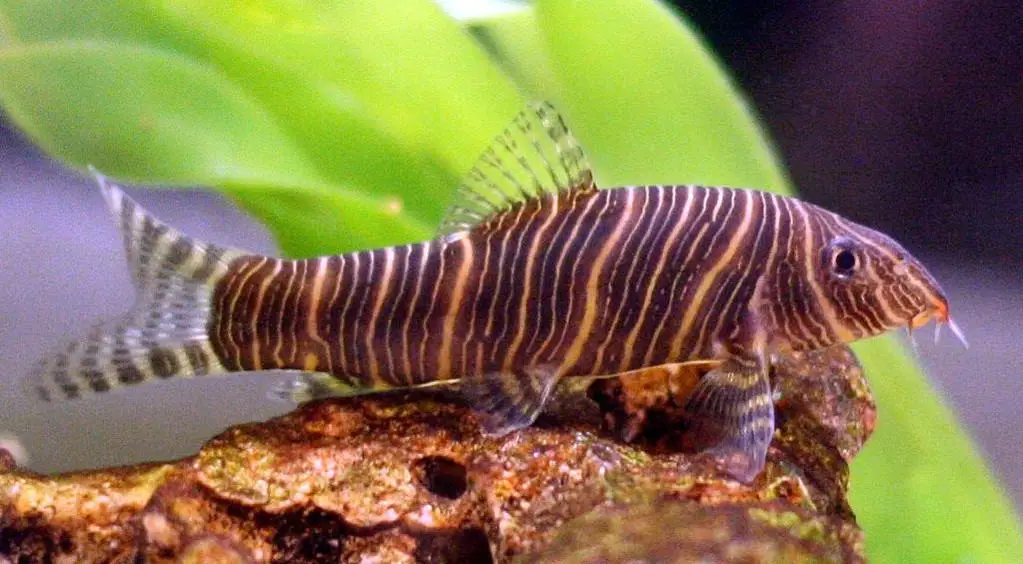
The Zebra Loach became popular for fish tanks in 1952. It dwells on the rivers and streams of the Western Ghats in India. Colors of the Zebra Loach may be bright orange, dull black, or yellowish.
Nevertheless, all species have the signature zebra-like pattern from head to foot.
Zebra Loaches love to swim in groups. In the wild, they usually swim on the bottom of the river and stream. Zebra Loaches are very active and love to explore debris or rocks.
The maximum size of the Zebra Loach is 9 cm. It sells for $7 – $10 at present.
Zebra Loach Profile
• Other Names: Candystripe Loach, Striped Loach, and Crossbanded Loach
• Life Span: 15 Years
• Diet: Mosquito Larvae, Tubifex, Brine Shrimp, Daphnia, and Algae Wafers
• Preferred Water Condition: Freshwater, Neutral, Cool (21 – 24 degrees Celsius)
• Minimum Tank Requirement: 30 Gallons (5 Zebra Loches)
• Suitable Tank Mates: Ghost Shrimp, Celestial Danio, Yoyo Loach, and Cherry Barb
Kuhli Loach
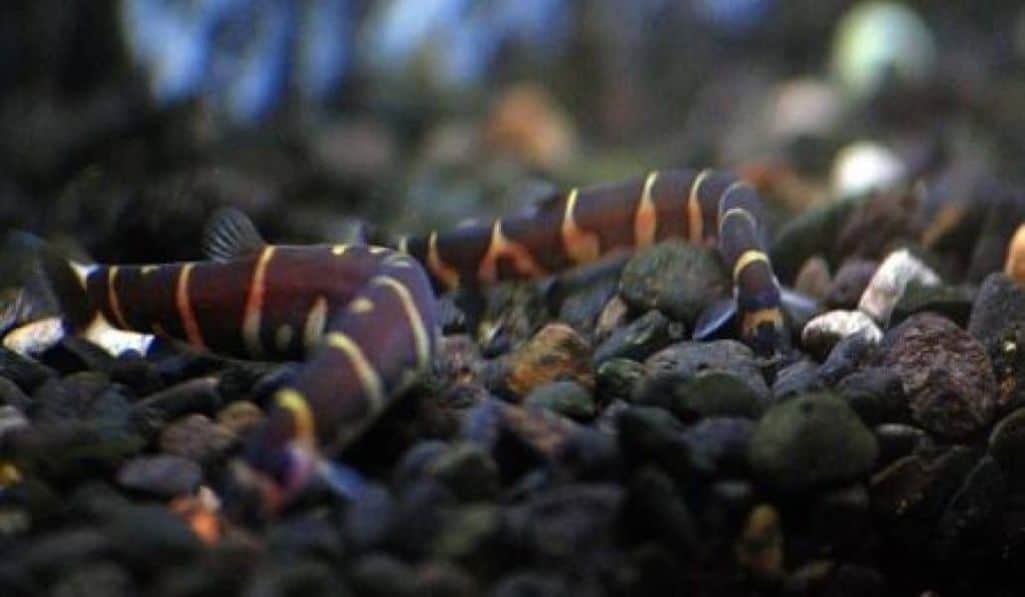
Valenciennes first gave a scientific description of the Kuhli Loach in 1826. The Kuhli Loach is native to Sumatra, Thailand, Malaysia, Singapore, and Borneo.
This fish resembles an eel. It may come in striped yellow, brown, and orange. Due to its coloration and body shape, some people mistake the Kuhli Loach to Coral Snakes.
Nevertheless, this mistake is very funny because Coral Snakes don’t thrive in freshwater. Most Kuhli Loaches have a maximum growth of 2 inches. Their price may range from $10 – $30.
The Kuhli Loach is one of the best ghost shrimp tank mates that don’t have scales. It’s prone to parasitic and bacterial disease. A common disease among Kuhli Loaches in captivity is the Ich.
To avoid this, ensure that the tank is fairly clean and be sure to maintain optimal water parameters.
Kuhli Loach Profile
• Other Names: Giant Coolie Loach, Leopard Loach, Coolie Loach, and Slimy Loach
• Life Span: 14 Years
• Diet: Pellets, Gel Treats, Bloodworms, and Blackworms
• Preferred Water Conditions: Freshwater, Neutral, Warm (26 – 28 degrees Celsius)
• Minimum Tank Requirement: 40 Gallons (6 Kuhli Loaches)
• Suitable Tank Mates: Ghost Shrimp, Neon Tetras, Ember Tetras, Cory fish, and Rasboras
Corydoras Varieties

Corydoras is a generic term referring to varieties of small freshwater catfish that mostly dwell in South America. There are more than 50 species of Corydoras recorded to date.
However, experts recommend only 7 for community tanks. These are the Bandit Cory, Bronze Cory, Julii Cory, Panda Cory, Pepper Cory, and Skunk Cory.
No matter which variety, a Corydoras may only reach a maximum size of 2.6 inches. In contrast, pricing depends on the specific species of the Corydoras.
Corydoras is a catfish. Surprisingly, it doesn’t follow a hardcore carnivorous diet just like its cousins.
This fish is a good tank mate for Ghost Shrimp because it mostly eats detritus and dead plant matter.
Corydoras Profile
• Other Names: Coryfish, Armored Catfish
• Life Span: 12 Years
• Diet: Tropical Granules, and Algae
• Preferred Water Condition: Freshwater, Neutral, Slightly Acidic, Slightly Cool (23 – 26 degrees Celsius)
• Minimum Tank Requirement: 20 Gallons (6 Corydoras)
• Suitable Tank Mates: Ghost Shrimp, Cherry Shrimp, Amano Shrimp, and Freshwater Snails.
Nerite Snail
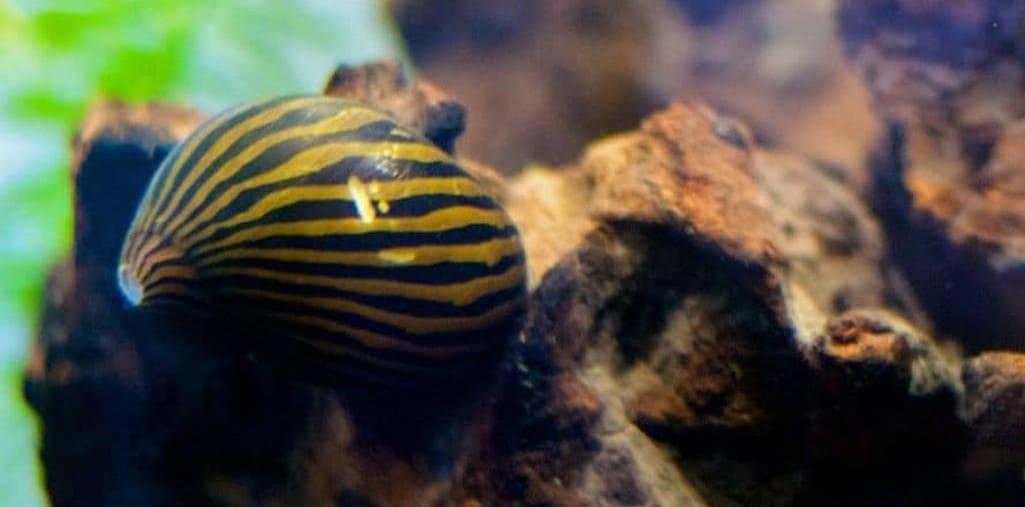
The Nerite Snail is a type of snail that’s abundant in African countries such as Kenya, Tanzania, South Africa, Somalia, and Mozambique.
This mollusk loves to dwell on coastal areas with lots of rocks. Sometimes it also lives on locations with lush mangrove populations.
The most popular varieties of the Nerite Snail are the Zebra Nerite Snail, Olive Nerite Snail, Horned Nerite Snail, and Tiger Nerite Snail.
Out of these, the most beautiful is the Tiger Nerite Snail that has a very intense striped orange coloration.
The Nerite Snail doesn’t like to move around. Furthermore, it likes locations in the community tank that provide shade.
Consider putting large rocks or large aquatic plants in the community tank when raising Nerite Snail with Ghost Shrimp.
Due to its vivid flashy appearance, the Nerite snail is one of the best ghost shrimp tank mates from the family of Mollusks.
Nerite Snail Profile
• Other Names: None
• Life Span: 1 – 2 Years
• Diet: Soft Film Algae, Soft Brown Algae, Soft Green Algae, and Brown Diatoms
• Preferred Water Conditions: Freshwater, Brackish, Slightly Acidic, Cool (25 degrees Celsius)
• Minimum Tank Requirement: 25 Gallons (5 Nerite Snail)
• Suitable Tank Mates: Ghost Shrimp, Neon Tetra, and Guppies
Otocinclus Catfish
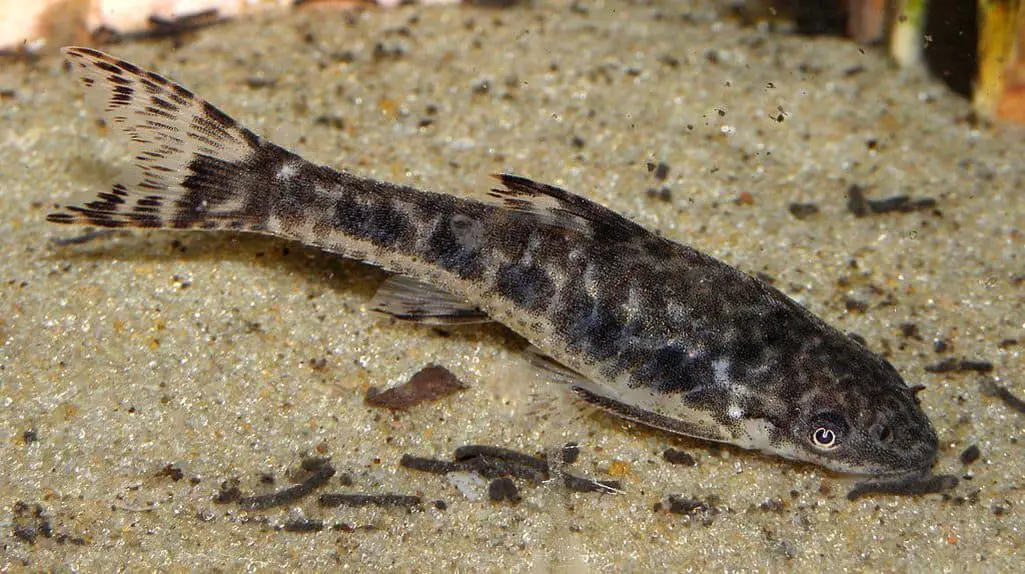
The Otocinclus catfish is a small species of catfish that are abundant in South America.
Though not particularly beautiful, fishkeepers love to raise it by itself or with other fishes due to its peaceful disposition and hardiness.
In its natural habitat, the Otocinclus Catfish usually swims on the bottom to feed on dead plant matter and other organic particles.
The Otocinclus catfish usually frequents aquarium plants in captivity. It also loves to swim near rocks and other ornaments.
This fish loves to eat algae and is an excellent fish tank cleaner. Water conditions that allow algae to thrive will make the Otocinclus Catfish very happy.
The Otocinclus Catfish grows up to 2 inches. It sells for $2 or $4 to date.
Otocinclus Catfish Profile
• Other Names: Oto Catfish, Oto Cats
• Life Span: 5 Years
• Diet: Zucchini and Soft Algae
• Preferred Water Conditions: Freshwater, Neutral, Slightly Acidic, Slightly Warm (24 – 28 degrees Celsius)
• Minimum Tank Requirement: 20 Gallons (10 Otocinclus Catfishes)
• Suitable Tank Mates: Ghost Shrimp, Angelfish, Zebra Loach, Cherry Barb, Guppies, and Mollies
Endler’s Livebearer
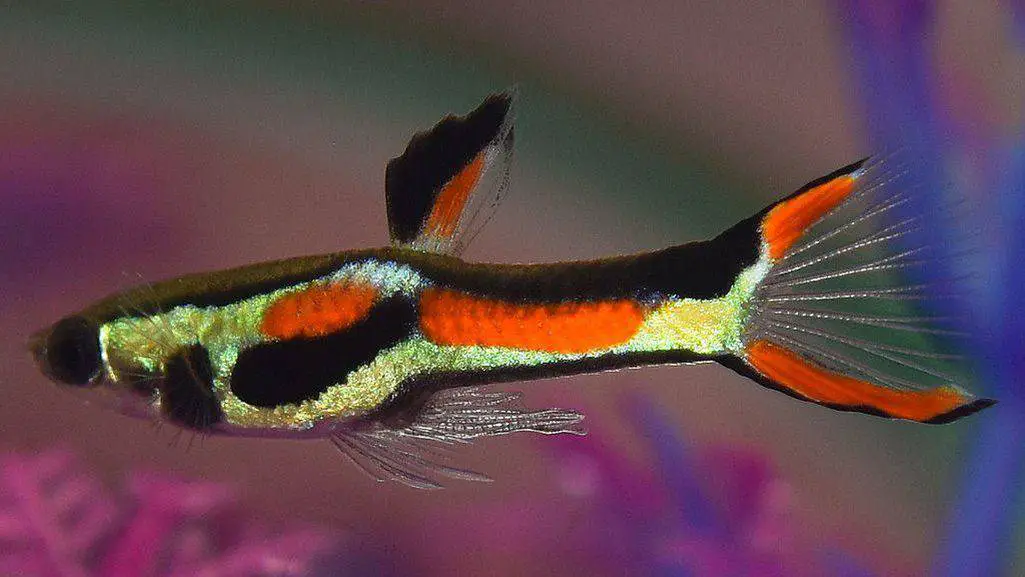
The first species of Endler’s livebearer was collected by Franklyn F. Bond in 1937 from the Laguna Pratos in Venezuela.
However, it was Dr. John Endler who scientifically described it in 1975.
Varieties of Endler’s Livebearer live in the Paria Peninsula of Venezuela. However, some sources state that Endler’s Livebearers are only exclusive to the Laguna Pratos.
Endler’s Livebearer comes with a silvery coloration with a slight hue of bright orange. In captivity, it loves to explore and can be seen swimming at the bottom, middle portion, and surface of the water.
This fish is one of the best ghost shrimp tank mates that also goes well with Guppies. It’s because Endlers and Guppies can crossbreed.
Endler’s Livebearers may grow up to 1.8 inches. Fishkeepers sell them for $3 or $5.
Endler’s Livebearer Profile
• Other Names: Cumana Guppy, Livebearer, Endler’s Guppy
• Life Span: 2 – 3 Years
• Diet: Blackworms, Bloodworms, Daphnia, and Brine Shrimp
• Preferred Water Conditions: Freshwater, Neutral, Warm (21 degrees Celsius)
• Minimum Tank Requirement: 10 Gallons (10 Endler’s Livebearers)
• Suitable Tank Mates: Ghost Shrimp, Neon Tetra, Glassfish, Zebra Loach, and Whitecloud Minnows
Amano Shrimp
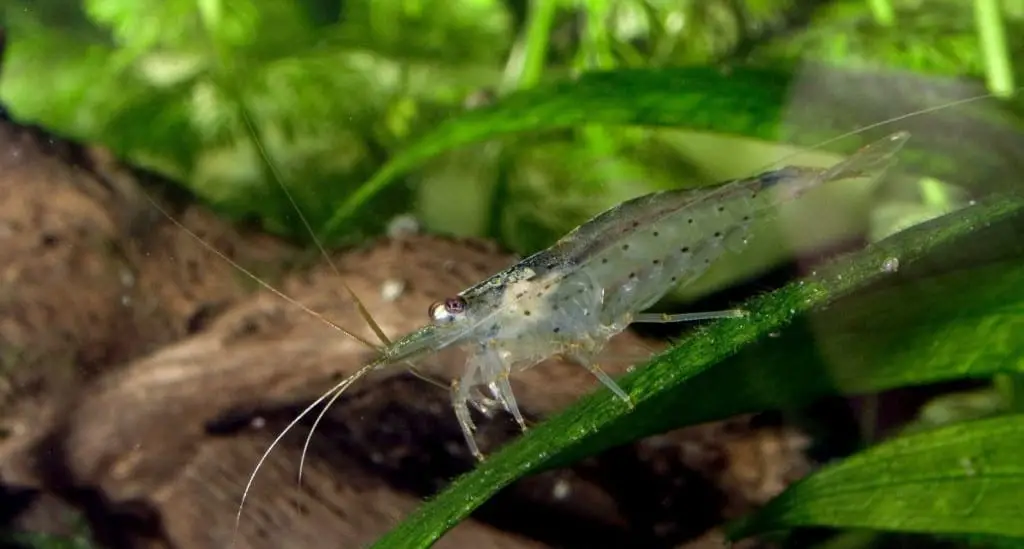
Takeshi Amano introduced the Amano Shrimp for tanks in the 1980s. The natural habitat of this crustacean is found in Taiwan, China, and Japan.
Amano Shrimps thrive in large groups in rivers and streams. This shrimp is very unique because it can also survive in saltwater.
The Amano Shrimp has a semi-translucent body. On the sides are black spots that are arranged neatly after each other.
Compared to the Ghost Shrimp, the Amano Shrimp comes second in terms of beauty.
However, this shrimp beats the Ghost Shrimp in terms of cleaning. Amano Shrimps are diligent algae eaters and won’t fail to keep the community tank clean.
The Amano Shrimp grows up to 2 inches. It sells for $3 at present.
Amano Shrimp Profile
• Other Names: Japonica Shrimp, Yamato Shrimp, Algae Eating Shrimp, Japanese Shrimp
• Life Span: 3 Years
• Diet: Algae and Algae Wafers
• Preferred Water Conditions: Freshwater, Saltwater, Neutral, Cool (24 degrees Celsius)
• Minimum Tank Requirement: 20 Gallons (5 Amano Shrimp)
• Suitable Tank Mates: Ghost Shrimp, Vampire Shrimp, Neon Tetra, Nerite Snail, Oto Catfish, and Bristlenose Pleco
The Basics To Ghost Shrimp Community Tank
Now that you know the best ghost shrimp tank mates, allow me to teach you one or two things about building a ghost shrimp community tank.
Recommended Size
Ghost Shrimps can be kept in small environments. The minimum tank requirement for raising them is 5 Gallons. However, you’re making a community tank. So I recommend that you use a 20 Gallon tank.
20 Gallon tank isn’t for your Ghost Shrimp. This is for the tankmates that will live with it. The most compatible companions for Ghost Shrimp love to move around. Thus, you should allow them to explore freely.
Learn How To Breed Ghost Shrimp
Ghost Shrimps don’t live for long. Usually, they only live for one year. Surely, you wouldn’t want to buy a new batch annually right?
Learning how to breed will prevent you from buying Ghost Shrimps repeatedly. Furthermore, it will get you prepared for breeding other aquatic animals.
Emulate The Ghost Shrimp’s Natural Habitat In The Community Tank
There should be a portion in the community tank that emulates the natural habitat of the Ghost Shrimp.
Such a location should have a rock or gravel substrate. Furthermore, there should be aquatic plants such as Java Moss, Java Fern, and Anubias.
In connection, the rest of the community tank should emulate the natural habitat of the Ghost Shrimp’s tank mates.
Conclusion
The animals that I mentioned are the best ghost shrimp tank mates. You should try to pick at least one of them and avoid going for fishes that are not part of the list if you’re a beginner.
Doing so will make it easier for you to take care of a Ghost Shrimp community tank.
Don’t be surprised if you don’t see Ghost Shrimps moving around too much. They’re not very active.
If you want to see Ghost Shrimps in action, making the community aquarium dimmer might help.
Lastly, try to follow the tips that I mentioned here. They’re some of the most basic things that will help you make a Ghost Shrimp community tank successfully.
Of course, you should be diligent about the maintenance after making one.
11 Best Cherry Shrimp Tank Mates (Pictures)




